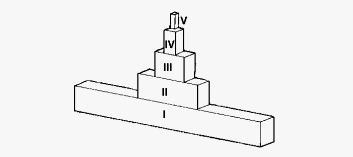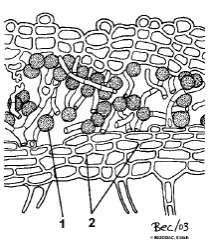Ecology is the area of Biology that studies the interaction between living beings and the environment in which they live.
Test your knowledge with 15 commented Ecology exercises from the main entrance exams.
1. (UFC) The mistletoe and some bromeliads are plants that photosynthesize and live on others. However, the mistletoe extracts water and mineral salts from the host plant while the bromeliads just lean on it. The relationships of mistletoe and bromeliads with host plants are, respectively, examples of:
a) parasitism and epiphytism.
b) epiphytism and holoparasitism.
c) epiphytism and predation.
d) parasitism and protocooperation.
e) teninism and epiphytism
Alternative a) parasitism and epiphytism.
Comment: Parasitism is the ecological relationship in which one species lives on top of the other and takes its food from it. In the case of mistletoe, it is considered a hemi-parasite, that is, it uses its host's resources, but is capable of carrying out photosynthesis. The bromeliads, on the other hand, only use their hosts as support, without taking any resources from them.
2. (ITA) The dynamics of the carbon cycle are very variable, both in space and time. Carbon emissions occur due to the actions of living beings or due to other phenomena such as a volcanic eruption
which, for example, causes a temporary increase in carbon in the atmosphere. The sequestration (absorption) of carbon from the atmosphere (CO2) is mainly made by chlorophylled beings that, in the photosynthesis process, synthesize the glucose molecule (C6H12O6). To keep carbon that has been removed from the atmosphere stored for the long term, it is advisable to:
a) control volcanic activities
b) transform forests into agricultural zones
c) install vegetable gardens in most homes
d) prevent deforestation and encourage reforestation
e) decrease biodiversity, facilitating calculations on respiratory activities
Alternative d) prevent deforestation and encourage reforestation
Comment: One of the ways to store carbon in the long term is to reduce emissions, which can be done through reforestation and also avoiding new deforestation.
3. (Fuvest) Most of the nitrogen that makes up organic molecules enters ecosystems through the action of:
a) seaweed
b) animals
c) bacteria
d) fungi
e) land plants
Alternative c) bacteria
Comment: In the nitrogen cycle we observe the important action of nitrifying bacteria. Nitrification is a chemical-biological process in which soil nitrite undergoes the action of nitrifying chemosynthetic bacteria, and the conversion of ammonia into nitrate occurs.
4. (PUC) Cyanobacteria can be considered self-sufficient living beings because they are capable of:
a) fix so much N2 how much CO2 in the form of organic matter
b) absorb calcium and nitrogen directly from the rocks
c) fix the H2 atmospheric in the form of organic matter
d) degrade any type of inorganic or organic matter
e) make phosphorus available to other living beings
Alternative a) set both N2 how much CO2 in the form of organic matter
Comment: Cyanobacteria were the most primitive producing beings, responsible for the initial accumulation of oxygen gas in the atmosphere. They are also N-fixers and contribute to soil and water fertility.
5. (Vunesp) Consider the following three food chains.
(I) vegetation → insects → amphibians → snakes → fungi.
(II) vegetation → rabbit → hawk.
(III) phytoplankton → zooplankton → fish → shark.
The greatest amount of energy available for the higher trophic levels will be:
a) only in the chain (I)
b) only in chains (I) and (III)
c) only in the chain (II)
d) only in chains (I) and (II)
e) in chains (I), (II) and (III)
Alternative c) only in chain (II)
Comment: Trophic levels represent the order in which energy flows in a given food chain.
Part of the energy produced is consumed at each trophic level (up to 90% of the energy produced), hence, the greater the proximity between consumers and the organism that starts the food chain, the greater the availability of energy.
Therefore, chain II is the one with the most energy for the highest trophic levels, as it is the one with the least amount of elements, with less energy loss and consequently greater energy availability for trophic levels superiors.
6. (UnB) What is the correct statement:
a) The place in the ecosystem where a certain species lives is called habitat.
b) Populations are sets of genetically equal individuals
c) Clone is a group of individuals of the same species that live in the same habitat
d) Ecosystem is the word used to indicate the set of populations in an environment
e) Community is the word that indicates the group of individuals of the same species that inhabit a region
Alternative a) The place in the ecosystem where a particular species lives is called habitat
Comment: Habitat designates the place where a particular species inhabits.
Considering the other alternatives, we have:
b) Population refers to the set of individuals, which are not necessarily genetically equal.
c) The term clone is used to refer to genetically identical individuals.
d) The ecosystem is the set of living organisms and their physical and chemical environments.
e) Community represents the set of populations that live in the same region, in which they live in a certain place, with specific environmental conditions and interacting with each other.
7. (UERJ) Ibama receives warning about the risk of an ecological disaster in burning areas
“Employees of the Felicidade farm, in Mato Grosso, observe cattle killed by the fire that destroys pastures
and you kill in the state and it doesn't stop advancing.”
(O Globo, 08/30/2010).
In the description above, we can find a primary consumer of the pasture food chain. This consumer has as a representative:
a) the cattle
b) the forest
c) the grass
d) the man
Alternative a) cattle
Comment: The primary consumer in a food chain is the one who feeds on producer beings. Therefore, among the options indicated are cattle.
8. (UFSC) The pyramid of numbers shown below concerns the trophic structure of a given ecosystem:

Check the correct sequence of organisms that corresponds to the increasing sequence of Roman numerals in the pyramid:
a) grasses, frogs, locusts, hawks, snakes.
b) hawks, snakes, frogs, grasshoppers, grasses.
c) hawks, grasshoppers, grasses, frogs, snakes.
d) grasses, grasshoppers, frogs, snakes, hawks.
e) grasses, grasshoppers, hawks, snakes, toads.
Alternative d) grasses, grasshoppers, frogs, snakes, hawks.
Comment: The pyramid represents the flow of energy and matter between trophic levels along the food chain. At its base we find producers, followed by herbivores and carnivores.
Thus, we have grasses (producing beings), locusts (herbivores), frogs, snakes and hawks (consumers).
See too: Food Chain Exercises
9. (USP) In an ecosystem, a fungus, an owl and a rabbit can play the roles, respectively, of:
a) decomposer, 2nd order consumer and 1st order consumer
b) producer, 1st order consumer and 2nd order consumer
c) 1st order consumer, 2nd order consumer and 1st order consumer
d) 2nd order consumer, 3rd order consumer and 1st order consumer
e) decomposer, 1st order consumer and decomposer
Alternative a) decomposer, 2nd order consumer and 1st order consumer.
Comment: The fungus is a decomposing being, as it decomposes organic matter. The owl is a second-order or secondary consumer, as it is carnivorous and feeds on primary consumers. The rabbit is a first-order or primary consumer, it is a herbivore and feeds on producing beings.
10. (UERN) An inherent characteristic of food webs is:
a) the increase in energy when moving from one trophic level to another;
b) the cyclical transfer of energy along food chains;
c) the same organism can occupy more than one trophic level;
d) the higher the trophic level, the greater the number of organisms occupying them;
e) the cycle of matter is disconnected from the action of decomposers.
Alternative c) the same organism can occupy more than one trophic level.
Comment: The same organism can occupy more than one trophic level, for example, some omnivorous animals can participate in more than one trophic level at the same time, as is the case with humans.
Considering the other suggested answers, we have the following statements:
a) The increase in energy decreases with the passage between trophic levels.
b) The food web consists of the interconnection between various food chains, in which the energy flow decreases with the passage between trophic levels.
d) the higher the trophic level, the smaller the number of organisms occupying it.
e) the action of decomposing beings is fundamental for the cycle of matter, they transform organic matter into inorganic matter, which will be used by producers, restarting the cycle.
11. (Enem) Considering the richness of Brazilian water resources, a serious water crisis in our country
could be motivated by:
a) reduced area of arable land
b) absence of groundwater reserves
c) scarcity of rivers and large hydrographic basins
d) lack of technology to remove salt from seawater
e) degradation of water sources and waste in consumption
Alternative e) degradation of water sources and waste in consumption.
Comment: We know that in Brazil we have a large amount of rivers, hydrographic basins and groundwater. However, in some aspects the management of water resources is problematic. As a result, the degradation of water sources and waste in consumption is common, situations that can lead to a serious water crisis in the country.
12. (Unifor-CE) Consider the food web below:

In this web, the organism that occupies the greatest number of trophic levels is:
a) the frog
b) the hawk
c) the snake
d) the thrush
e) the spider
Alternative b) the hawk
Comment: The hawk is a tertiary consumer and feeds on secondary consumers, so it has the highest number of trophic levels.
13. (PUC) What type of interspecific interaction exists between cattle and microorganisms that
live in your digestive tract?
a) Parasitism
b) Tenancy
c) Commensalism
d) Mutualism
e) Herbivory
Alternative d) Mutualism.
Comment: In mutualism both benefit from the association that is so deep that their survival becomes essential. In the case of cattle and microorganisms, the relationship is fundamental for the existence of the species.
14. (UEMG-2006) Lichens are associations between two organisms. They are so specific that they are classified as a unique species. A lichen of the genus is shown below. Coccocarpy, in its microscopic structure.

Regarding the lichens and components represented in the figure above, it is CORRECT to state that:
a) grow only in nutrient-rich soil.
b) structures 2 represent autotrophic organisms.
c) are highly tolerant to air pollution.
d) are pioneer organisms in ecological succession.
Alternative d) are pioneer organisms in ecological succession.
Comment: Lichens are organisms formed by an interspecific association between algae and fungi. Algae are autotrophic beings and are responsible for carrying out photosynthesis, which provides organic substances for the fungi. In ecological succession processes, lichens are the first organisms to emerge.
15. (UniFor) Consider the phrase: "The fungus Penicillium notatum produces penicillin, which prevents the multiplication of certain bacteria". She exemplifies a case of:
a) predatory
b) competition
c) mutualism
d) monthly
e) commensalism
Alternative d) amensalism
Comment: Amensalism is a type of ecological relationship in which one species prevents the development of another.


